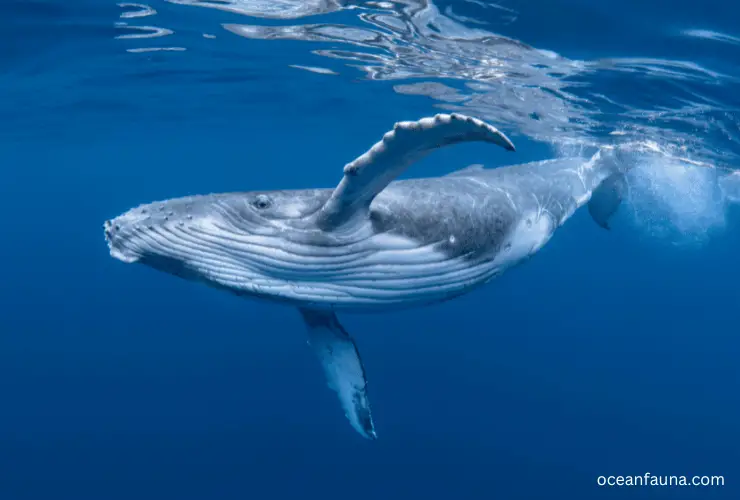Whales are one of the top marine mammals. Have you ever wondered, “Do whales have blood?” Well, yes. Whales do have blood. They are warm-blooded mammals, similar to humans.
However, their blood differs significantly from ours due to their unique anatomical adaptations for oceanic habitats. In this blog, I will discuss the whale’s blood and its unique formation in detail.
Do Whales Have Blood?
As previously discussed, whales have blood. However, their blood exhibits notable distinctions from ours, owing to their remarkable anatomical adaptations for thriving in aquatic habitats. These adaptations have facilitated their flourishing in a marine environment that would be hostile to most terrestrial creatures.
Whales are warm-blooded mammals, which means they regulate their internal body temperature. This adaptation is essential for survival in the cold waters that they inhabit. Unlike fish, which are cold-blooded, whales can maintain a constant body temperature of up to 99 degrees Fahrenheit, regardless of the temperature of the surrounding water.
To achieve this, whales have a highly specialized circulatory system, with a larger and more efficient heart than most other mammals of similar size. Their blood has a higher concentration of oxygen-carrying red blood cells than human blood, allowing them to extract more oxygen from each breath of air.
Another unique feature of whale blood is its ability to tolerate high carbon dioxide and lactic acid levels. While these compounds would be toxic to most other animals, whales can maintain high levels of both in their blood without negative consequences. This adaptation enables them to dive for extended periods without the need for frequent resurfacing to breathe.
Anatomical Formation of Whales’ Blood

Whale blood is a unique and highly specialized circulating system adapted to their unique aquatic lifestyle. The anatomical formation of whale blood is an intricate process involving integrating several physiological systems to ensure maximum oxygen-carrying capacity and prolonged diving times.
Composition
Whale blood is a complex mixture of living cells and various dissolved components that work together to support the vital functions of various organs. The composition of whale blood is remarkably different from other mammals of similar size, which makes it a highly adaptive and versatile system.
The whales’ blood contains more red blood cells, hemoglobin, and oxygen-carrying proteins. This unique composition allows whales to store twice as much oxygen for long dives and sustain their metabolic rate without frequently resurfacing for air.
Red Blood Cells
Red blood cells are integral to whale blood and transport oxygen and carbon dioxide to and from various organs. The blood of whales has a higher concentration of red blood cells than human blood, which allows them to extract more oxygen from each breath of air they take.
The red blood cells of whales are structurally different from those of humans and have an elongated and flexible shape, allowing them to squeeze through narrow capillaries more easily.
Hemoglobin
Whale blood exhibits a significantly higher concentration of hemoglobin compared to human blood. Hemoglobin, an iron-containing protein responsible for oxygen transportation to various organs, is found in double the amount in whales’ blood compared to ours. Consequently, while human blood comprises 30% hemoglobin, whale blood contains 60% hemoglobin.
The elevated hemoglobin concentration in whale blood facilitates the storage of twice as much oxygen during prolonged dives, serving as a vital adaptation for their aquatic lifestyle.
Carbon Dioxide Tolerance
Whales have the unique ability to tolerate high levels of carbon dioxide in their blood without negative consequences. This adaptation enables them to dive for extended periods without resurfacing for air frequently.
The ability to tolerate high levels of carbon dioxide is due to the presence of carbonic anhydrase, an enzyme that converts carbon dioxide into bicarbonate, a less toxic molecule.
Lactic Acid Tolerance
Whales also have a high tolerance for lactic acid, which accumulates in the blood during prolonged dives. Lactic acid is produced during anaerobic metabolism and causes muscles to fatigue and potentially harm organs.
However, whales have specialized systems that pump lactic acid out of the blood and into tissues where it can be reconverted into less toxic compounds. This adaptation is essential for whales to remain active during prolonged dives and avoid muscle fatigue.
What Color Is Whale Blood?

Do whales have red blood? Yes, whales, like most vertebrates, have red blood. However, their blood is not a light red like ours. Due to significantly higher levels of proteins such as hemoglobin and myoglobin, which are responsible for storing oxygen, their color is a very dark red, almost black. These proteins greatly enhance the oxygen-carrying capacity of whale blood, enabling them to thrive in the oxygen-poor environment of the deep ocean.
Hemoglobin and myoglobin are heme-containing proteins responsible for binding oxygen to transport it throughout the body. In whales, the concentration of these proteins is significantly higher than in other mammals, leading to the distinctive color of their blood and muscles. This adaptation allows whales to dive to great depths where oxygen is scarce for extended periods of time, making them more efficient hunters and swimmers.
Interestingly, the color of whale blood varies slightly depending on the species. For example, the blood of humpback and fin whales is a brighter shade of red compared to the darker blood of blue and sperm whales. This variation may be due to differences in the types and concentrations of heme-containing proteins found in each species.
How Does a Whale Pump Their Blood?
A whale’s heart is a remarkable feat of nature, designed to pump blood through its enormous body. For example, the heart of a blue whale is a marvel of engineering, weighing an astonishing 1,000 kg and pumping an incredible 220 liters or 58 gallons (approx) of blood with every beat. This heart is so large that it’s roughly the size of a small car, highlighting just how much energy is required to keep a creature of that size alive and thriving.
The whale’s heart is a four-chambered organ where blood flows through four distinct areas. The first chamber is called the right atrium, which receives blood from the body’s veins. This blood is low in oxygen and is returned to the heart for re-oxygenation before being sent back to the body. Next, the blood passes into the right ventricle, where it’s pumped to the lungs, picking up fresh oxygen on its way.
After the blood has been oxygenated, it’s returned to the heart in the left atrium. The left atrium receives freshly oxygenated blood from the lungs, which is then passed down to the left ventricle. The left ventricle is the strongest part of the heart, and it’s in this chamber the oxygenated blood is pumped out to the body, providing the cells and tissues with the vital nutrients and oxygen they need to survive.
Whales and other marine mammals have a unique way of pumping blood through their bodies, unlike land-dwelling animals. When a whale dives deep into the ocean to forage for food, the pressure at these depths can be immense, and it can be challenging to maintain blood flow throughout the body. In response to this challenge, whales have developed a sophisticated blood pressure regulation method.
To maintain blood circulation during deep dives, whales rely on their massive hearts to store large amounts of blood in the veins that lead to their lungs. By doing this, they reduce the blood volume that needs to be pumped during a dive, decreasing the risk of pressure-related injuries such as the ‘bends.’
As the whale ascends to the surface, the pressure lessens, and blood returns to the heart, pumping it around the body. The unique design of a whale’s circulatory system ensures that its organs receive enough oxygen and nutrients to function correctly, no matter how deep the creature dives.
Similarities and Dissimilarities Between Whale Blood and Human Blood

Whales and humans both are mammals. Although their anatomy, habitat, lifestyle are different, they have blood. And in their blood there are some similarities and similarities.
Similarities between Whale Blood and Human Blood
Humans and whales are warm-blooded animals, so there are a lot of similarities between their blood. Here they are-
- Whales and humans have red blood, a trait most vertebrates share. The red color is due to the presence of hemoglobin, a protein that binds to oxygen and transports it throughout the body.
- Both species also have four-chambered hearts, with blood flowing through four distinct areas: the right atrium, right ventricle, left atrium, and left ventricle. The general function of hemoglobin and the overall structure and operation of the heart and circulatory system are similar between the two species.
Dissimilarities between Whale Blood and Human Blood
Despite all the similarities, notable differences exist. Here they are-
- Whales have a significantly higher hemoglobin concentration in their blood compared to humans. While human blood comprises 30% hemoglobin, whale blood contains 60%. This enables whales to store more oxygen during dives and aids their survival in oxygen-poor environments.
- Whales also exhibit a high tolerance for carbon dioxide, facilitated by the presence of an enzyme that converts carbon dioxide into a less toxic molecule. This adaptation is not present in humans, necessitating us to promptly exhale carbon dioxide.
- Whale’s tolerance for lactic acid, a byproduct of anaerobic metabolism, is another significant difference. Unlike humans, whales have systems to pump out lactic acid from the blood into tissues, where it’s transformed into less harmful compounds.
- Although whales and humans have red blood, there are some differences in color density. The color of whale blood is darker due to the higher concentration of hemoglobin and myoglobin compared to the lighter red color of human blood.
- The whale’s heart and circulatory system are uniquely designed to withstand the immense pressure of deep-sea diving. They store large amounts of blood in the veins, leading to their lungs, reducing the blood volume that needs to be pumped during a dive. This adaptation to deep-sea pressure is not observed in humans.
Conclusion
Now you know almost everything that you should know about whales’ blood. In addition, I have discussed some similarities and dissimilarities of both human’s and whale’s blood. The notable point is that whales have blood that contains 60% hemoglobin, which provides the capability to store more oxygen during dives.
If you have more questions on whale blood, let me know. I will try to answer them ASAP.

